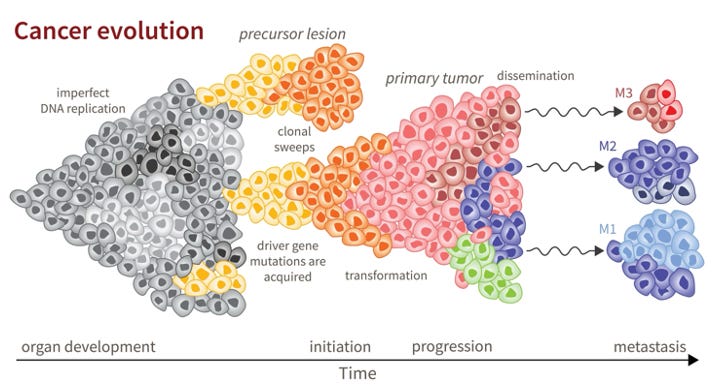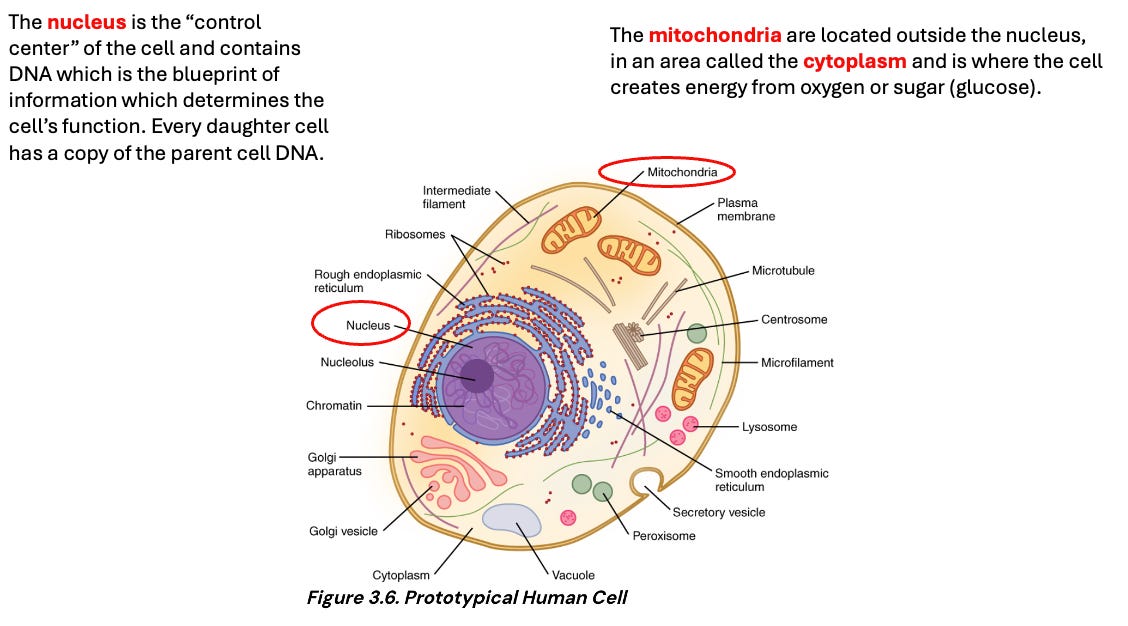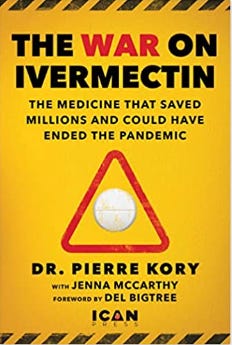The Scientific Basis For The Somatic Mutation Theory Of Cancer Is Invalid
The consensus theory explaining the cause of cancer is called the Somatic Mutation Theory. It has guided research and treatment in cancer for over 70 years. Let's examine its (non) validity.
In this post, I plan to, as succinctly and simply as possible, introduce the two competing theories regarding the origin of cancer and then go through the evidence for the current “consensus” theory which is called the Somatic Mutation Theory or SMT. The competing theory, called the Metabolic Theory of Cancer (MTOC) will be further detailed and explained in my next post in this series.
First, let’s define cancer. From the seminal paper “Hallmarks of Cancer” by Weinberg and Hanahan, a cell is defined as “cancerous” when they exhibit these 8 characteristics;
it stimulates its own growth
it evades growth suppressing signals
it resists cell death (apoptosis)
it enables replicative immortality
it induces the ability to grow new blood vessels to further tumor growth (angiogenesis)
it spreads to distant sites (metastasis)
it has the ability to evade the immune system
it has a “reprogramming of energy metabolism” (the “Warburg Effect)
In layman’s speak - cancer is the uncontrolled growth of a cell - ever dividing and not dying off naturally nor allowing itself to be cleared by the immune system. Plus, it allows itself to spread and then multiply in areas of the body distant from its origin (a characteristic for which no mutation has ever been found to explain this property but forgive me for I am getting ahead of myself).
Now, one of the main points of this post is that characteristic #8, that of having undergone a “reprogramming of energy metabolism” (the central pillar supporting the MTOC) was only added to the list above after one of the top SMT cancer researchers in the world was “admonished” to do so by one of the top researchers of the MTOC. Although it was added only 10 years ago, Warburg discovered this unique property of a cancer cell back in 1927.
Now, to understand the core difference between the two theories you will need a simple understanding of cell biology, i.e. the basic structure and function of a cell. So, as simply as possible, know these two things about cells:
THE NUCLEUS (Central to the Somatic Mutation Theory)
What you need to know about the nucleus is:
The nucleus is generally considered the control center of the cell because it stores all the genetic instructions (DNA) for manufacturing proteins used by the cell.
The DNA is the blueprint of instructions that dictates everything a cell will do and all of the products it will make (the information is contained in “genes” within the DNA - short sequences of “instructions”).
When a cell divides, the DNA must be duplicated so that each new cell receives a full complement of the parent cell’s DNA.
The “Somatic Mutation Theory” posits that cancer arises from the accumulation of genetic mutations (errors) in tumor suppressor or tumor promoter genes within the DNA of the nucleus, causing the aberrant behaviors listed above. These mutations are caused by various “carcinogens” (agents that cause cancer) within our environment.
THE MITOCHONDRIA (Central to the Metabolic Theory)
All you need to know about the mitochondria is:
A mitochondrion is a membranous, bean-shaped organelle that is the “energy transformer” of the cell. Each cell has numerous mitochondrion.
Along its inner membrane is a series of proteins, enzymes, and other molecules that perform the biochemical reactions that convert either oxygen or glucose into energy in the form of adenosine triphosphate (ATP), which provides usable cellular energy
Cells use ATP constantly, and so the mitochondria are constantly at work.
Oxygen molecules are required to make ATP, which is why you must constantly breathe. Converting oxygen to ATP is a process called “aerobic respiration.” There is also another, less efficient pathway that a mitochondrion can make energy by, and that is via using sugar (glucose), a process called “anaerobic respiration” or “fermentation.”
The “Metabolic Theory of Cancer” posits that carcinogens, instead of directly damaging DNA, instead first damage the mitochondria in such a way that they cannot use oxygen to create energy and are instead forced to rely near solely on sugar (glucose) for energy.
This abnormal respiration is exhibited by ALL cancer cells. The MTOC experts argue that it is this reliance on an alternative energy pathway by dysfunctional mitochondria which then induce mutations in the nucleus such that tumor suppressor genes are “turned off” and tumor promoter genes are “turned on .“
An important concept to know which will begin to reveal my bias in support of the MTOC is that abnormal respiration is present in every cancer cell, but not every cancer cell has been found to have mutations in their DNA. Tumors free of any mutations can even possess aggressively cancerous properties.
THE HISTORY OF THE SOMATIC MUTATION THEORY (SMT)
These were the pivotal discoveries which led to the creation of the SMT as the prevailing theory of cancer over the last 70 years:
The Concept Of A Carcinogen Was Identified
1770’s - Percival Pott first introduced the concept of a “carcinogen” based on his study of chimney sweep boys who developed high rates of testicular cancer. He concluded there were substances in the soot which must have capacity to cause cancer, i.e. a “carcinogen”
Cancer Cells Were Found To have Abnormal Chromosomes
1890 - David Paul von Hansemannfirst identified that chromosomes in the nucleus (only much later were they found to be composed of DNA) were chaotic, bent, and broken in cancer cells and assigned the cause of cancer to “asymmetric divisions” or “intracellular arising abnormalities to their hereditary material.”
Viruses Were Found To Cause Cancer
1910-11 - Francis Peyton Rous found that injecting tumors from a cancerous hen into others caused cancer. When he filtered out all possible cells and organisms larger than a virus, it still caused cancer. He then concluded that cancer was virally transmitted, introducing the infectious theory of cancer.
The Discovery of DNA
1952 - James Watson and Francis L Crick discovered DNA as “the information (or code) of life,” a feat recognized as one of the most major scientific discoveries in history and which won them the Nobel Prize. Cancer researchers were captivated by this discovery and immediately theorized that mistakes (or insults) in the DNA could explain why a cell become cancerous. This theory tied together Hansemann’s findings of chromosomal damage in cancer cells, strengthening the belief that cancer was a disease of the DNA! Further, the fact that daughter cells (which contained the parent DNA) were also cancerous even more solidified that the problem was in the DNA.
Viruses Found To Impact Gene Expression
1976 - Harold Varmus and J. Michael Bishop, building on Rous’s earlier finding, discovered that cells exert their cancer causing effects by turning on genes or mutating genes. They identified that normal genes (proto-oncogenes) could become altered by a virus and become an oncogene (gene causing cancer). Their protein products then sabotaged the cellular controls, causing the cell to become cancerous. This tied in Rous’s observations that viruses can cause cancer.
As Christofferson wrote in his book Tripping Over The Truth: How The Metabloic Theory Of Cancer Is Overturning One Of Medicine’s Most Entrenched Paradigms
“Varmus and Bishop tied them all together to found the SMT which has been the foundational, total and guiding theory of cancer since the early 1970’s. The door slammed shut on Warburg (who died in 1970) and few would look back (Ed: More on Warburg in Part 3).
The SMT was further developed by the work of Bert Vogelstein in 1989 when he found that one gene, the p53 gene, was not an oncogene but rather that it was a “tumor suppressor” gene which was very commonly mutated in cancer - a p53 mutation is found in over 50% of cancers.
Vogelstein was the first to propose that cancers “progress” via successive mutations, and that each stage was marked by the development of a specific mutation. He argued that cancer was an “orderly disease” with discreet stages in developing all the characteristics above of a cancer cell. His work deepened the belief from the 90’s to today that cancer is a genetic disease, with the last few decades marked by an obsessive search for “mutations” in DNA that cause cancer. This consensus belief still continues to guide research in therapeutics by trying to find drugs that counteract the consequences of each mutation.
The SMT Starts To Run Into Trouble
Human Genome Project (HGP), 1990-2003
Technology for sequencing DNA was developed in the 1970’s and 80’s, and in 1990, the HGP was launched. It attempted to sequence the entire human genome of 3 billion base pairs. The project succeeded in doing so over the next 15 years, initially described as “the “biggest, costliest, most provocative biomedical research project in history.” It cost $3 Billion.
Not so fun fact - James Watson, one of the discoverers of DNA, was originally the director of the project but he disagreed with the plan to make human genes patentable. So he was forced out and replaced by.. oh boy.. Francis Collins (head of NIH during Covid, i.e. Fauci’s supposed boss).
From Tripping Over The Truth (TOTT) by Travis Christofferson:
At the time of the HGP, the cost to sequence all 3 billion base pairs was $500 million. By 2007, the technology had improved to the point where to do the same it only cost $8.9 million (today it would cost 5K and take 2 days). Whoa. In 2005 the Cancer Genome Atlas Project (TCGA) was announced to “accelerate our understanding of the molecular basis of cancer through the application of genome analysis.”
The Cancer Genome Atlas Project (TCGA)
In 2005, the TGCA project began, headed by Bert Vogelstein, the famous researcher above who discovered the p53 mutation and who proposed that cancer progressed through an orderly series of successive mutations. His theory ran into problems within one year of the project.
Initially, they did a systematic screening of eleven patients with breast cancer and eleven with colon cancer. More than 18,000 genes were sequenced. What the TGCA found was (again from TOTT:
random mutations all over the place - no “orderly progression” as per Vogelstein’s theory
very few previously unknown oncogenes were found
no single mutation was identified that qualified it as a “starting mutation” of cancer
mutations differed vastly from person to person, a phenomenon called “inter-tumoral heterogeneity” – further contradicting the idea that cancer arises from a sequence of successive mutations
even within a single patients’ tumor, mutations varied widely among different cells, i.e. “intra-tumoral heterogeneity.”
This suggests that designing drugs to target genetic abnormalities would be next to impossible in most cancers (there are exceptions)
they also found “inter-metastatic heterogeneity” - different sites of metastases had different mutations present
in breast cancer, mutations causing the disease ranged from a maximum of 6 in one tumor, but others had only a single mutation and five had no mutations at all! This lack of a founding mutation brought the SMT even more into question.
Most important is that if mutations were the cause of cancer, then every daughter cell or clone of that cancer cell, would have to have that “founding” mutation. If you can confirm cases without a founding mutation, the SMT is dead. No founding mutation has been found to date.
The import of the above is that it essentially contradicts the theoretical “pillars” of the SMT, in particular the supposition that cancer cells are “clonal”, i.e. that each daughter cell is a copy of its parent. That is clearly not always the case, nor even close.
In response to all these data, Vogelstein, who was essentially the top cancer researcher and chief proponent of the SMT, tried to “tweak” the SMT to fit these data by arguing that cancer was instead simply cellular dysfunction caused by different mutations and then he came up with 12 distinct biological systems to explain the ways in which cancer cells are dysfunctional.
This is not a good look in science when your theory needs to be patched up in such a complex way for it to still seem logical. Recall Occam’s Truth which largely translates to “the simplest answer is the most true” (and wait for my next post on the MTOC). He then tried to ascribe the known mutations to one of the 12 systems (with difficulty as some of the mutations caused things that were not directly related). As Christofferson argues, “some thought it an ad hoc modification necessary to make a failed theory fit the data.”
But more sequencing would follow, for instance when they focused on Glioblastoma Multiforme (GBM):
yes, a novel oncogene was found - but only in 12% of samples
only four of the 22 samples had mutations directly impacting the three “biological systems” needed to be dysfunctional so that GBM would supposedly result
9 samples had mutations affecting only 2 of the systems
one sample had no mutations affecting any of the 3 systems - and that was an aggressive GBM.
From TOTT:
Each person’s tumor was unique! Like a snowflake - thus, no consistent therapeutic target (unlike in metabolic theory). SMT and the dysfunctional systems theory was dead. This also threatened the entire pharmacologic approach - with so many mutations, how can you develop a gene based therapy or specific therapy for each one? (which takes hundreds of millions to bring a novel drug to market) . Basically the TCGA showed this approach to be an exercise in futility (with a couple of rare exceptions/successes).
In response, Vogelstein then invented the concept of “dark matter” to explain the holes in SMT – finding that cancer was just too complex, like the galaxies and stars. Dark matter? After this, he apparently gave up on studying the causes of cancer and instead switched his career research focus from genetics to diagnostic methods.
The SMT ran into even more trouble (if that is possible) in 2010, when a researcher named Larry Loeb at the University of Washington attempted to summarize what had been learned about cancer at the time in a review paper. As Christofferson described it, “he addressed the elephant in the room.”
Loeb basically argued that in our cell’s nucleus there are so many DNA repair mechanisms that spontaneous mutations are actually quite rare but cancer is not! He said “if cancer requires as many as 12 different mutations, and spontaneous mutation rates are really low - cancer should be very rare.”
Ultimately, the SMT is invalid based on the lack of “founding mutations” that would need to be present in every cancer cell.
However, there is still a way to “save” the SMT, i.e. make it make sense. But to do that, it would have to be married or “fit in” to another theory that makes more foundational sense. That is where the MTOC comes in. Check out Part 3 (coming soon) where I will explain how the two theories fit together in a way that elegantly explains how cancer arises and progresses.
I just want to say thanks to all my subscribers, especially the paid ones! Your support is greatly appreciated as it allows me to devote what is often large amount of time I spend researching and writing my posts, so again, thanks. - Pierre
P.S. For anyone in need of treatment for cancer (note we one of the treatment sites for the repurposed drug trial described here) or for Long Covid, Long Vax, Hormone Rebalancing, Weight Loss or General Medical Care, feel free to visit the Leading Edge Tele-Health Clinic. Looking at the photo below, I just realized our staff is a lot bigger now - we just added our 20th employee!
P.P.S - Proud to report that my book has gained Best Seller status on Amazon in several countries and is still up there on U.S Amazon rankings. *If any of you have read it, I would love if you could post an honest review!






No comments:
Post a Comment